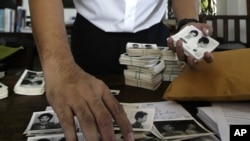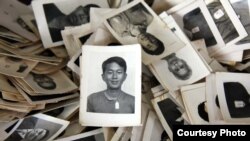More than 1,400 photographs of inmates facing certain death four decades ago in a notorious Khmer Rouge torture center have been presented to an official Cambodian archive.
The photos were donated anonymously this month to the Documentation Center of Cambodia. They stunned archivists with rich details of prisoners held at the Tuol Sleng prison during the 1975-1979 rule of the extremist group.
Documentation center chief Chhang Youk tells VOA's Khmer Service the back of each passport-size photo contains information on each prisoner, with much of it written by the prisoners themselves.
"It will prove extremely important in helping living family members identify and locate their lost relatives," he said. "After all these years, the Cambodians are looking for the peace of memories left behind by their loved ones in the grip of the Khmer Rouge - handwriting, names and photographs - so they can move on with their lives."
A place of unrivaled infamy
Tuol Sleng chief Duch, who was later imprisoned for war crimes, kept meticulous records of prisoners and their forced confessions. But researchers say most of those records were lost in the upheaval that followed the defeat of the Khmer Rouge by Vietnamese forces in 1979.
Khmer Rouge researcher Peter Maguire, who authored Facing Death in Cambodia, said "archives were literally blowing in the wind" and remained highly disorganized for years.
US legislates Cambodian Genocide Justice Act
But in 1994, the U.S. Congress approved a measure urging then-President Bill Clinton to approve a program helping organizations and individuals collect data on the genocide. The assistance program then chartered a group of academics at Yale University to spearhead collection efforts under the banner of the Documentation Center for Cambodia.
Two years later, the Center was archiving what would become a trove of more than 155,000 documents and 5,000 photos. For his efforts, Chhang Youk was named in 2006 to Time Magazine's annual list of "100 Most Influential People."
Author Maguire describes the Center as an "independent historical broker," noting that it operates free of government influence, as an international tribunal in Phnom Penh continues hearing war crimes cases brought against three surviving Khmer Rouge leaders.
New photos a boon to families, but legal value unclear
Legal analysts are not yet certain what role, if any, the new photos will play in the ongoing trials. But Chhang Youk says the photos' greatest value is the emotional impact they will have on the heirs of the four-year calamity at Tuol Sleng and beyond.
"In the case of these pictures, families are more important than the tribunal," he said. "These pictures bring closure .....they contain information [proving] that no one, no genocide, can ever completely destroy a human race. There's always something left behind."
Chhang Youk also took note of the photos' donor, a woman who worked for the People's Republic of Kampuchea, which took over when the Khmer Rouge was ousted in 1979. She acquired the pictures decades ago and held onto them for years.






